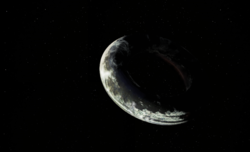Toroidal planet

A toroidal planet is a hypothetical type of telluric exoplanet with a toroidal or doughnut shape. While no firm theoretical understanding as to how toroidal planets could form naturally is necessarily known, the shape itself is potentially quasistable,[1] and is analogous to the physical parameters of a speculatively constructible megastructure in self-suspension, such as a Dyson Ring, ringworld, Stanford torus or Bishop Ring.
Physical description
At sufficiently large enough scales, rigid matter such as the typical silicate-ferrous composition of rocky planets behaves fluidly, and satisfies the condition for evaluating the mechanics of toroidal self-gravitating fluid bodies in context.[2] A rotating mass in the form of a torus allows an effective balance between the gravitational attraction and the force due to centrifugal acceleration, when the angular momentum is adequately large. Ring-shaped masses without a relatively massive central nuclei in equilibrium have been analyzed in the past by Henri Poincaré (1885),[3] Frank W. Dyson (1892), and Sophie Kowalewsky (1885), wherein a condition is allowable for a toroidal rotating mass to be stable with respect to a displacement leading to another toroid. Dyson (1893) investigated other types of distortions and found that the rotating toroidal mass is secularly stable against "fluted" and "twisted" displacements but can become unstable against beaded displacements in which the torus is thicker in some meridians but thinner in some others. In the simple model of parallel sections, beaded instability commences when the aspect ratio of major to minor radius exceeds 3.[4][5]
Wong (1974) found that toroidal fluid bodies are stable against axisymmetric perturbations for which the corresponding Maclaurin sequence is unstable, yet in the case of non-axisymmetric perturbation at any point on the sequence is unstable.[6] Prior to this, Chandrasekhar (1965, 1967), and Bardeen (1971),[7] had shown that a Maclaurin spheroid with an eccentricity is unstable against displacements leading to toroidal shapes and that this Newtonian instability is excited by the effects of general relativity. Eriguchi and Sugimoto (1981) improved on this result, and Ansorg, Kleinwachter & Meinel (2003) achieved near-machine accuracy, which allowed them to study bifurcation sequences in detail and correct erroneous results.[8]
While an integral expression for gravitational potential of an idealized homogeneous circular torus composed of infinitely thin rings is available,[9] more precise equations are required to describe the expected inhomogeneities in the mass-distribution per the differentiated composition of a toroidal planet. The rotational energy of a toroidal planet in uniform rotation is where is the angular momentum and the rigid-body moment of inertia about the central symmetry axis. Toroidal planets would experience a tidal force pulling matter in the inner part of toroid toward the opposite rim, consequently flattening the object across the -axis. Tectonic plates drifting hubward would undergo significant contraction, resulting in mountainous convolutions inside the planet's inner region, whereby the elevation of such mountains would be amplified via isostasy due to the reduced gravitational effect in that region.
Formation
Since the existence of toroidal planets is strictly hypothetical, no empirical basis for protoplanetary formation has been established. One homolog is a synestia, a loosely connected doughnut-shaped mass of vaporized rock, proposed by Simon J. Lock and Sarah T. Stewart-Mukhopadhyay to have been responsible for the isotopic similarity in composition, particularly the difference in volatiles, of the Earth-Moon system that occurred during the early-stage process of formation, according to the leading giant-impact hypothesis.[10] The computer modelling incorporated a smoothed particle hydrodynamics code for a series of overlapping constant-density spheroids to obtain the result of a transitional region with a corotating inner region connected to a disk-like outer region.
Occurrence
To date, no distinctly torus-shaped planet has ever been observed. Given how improbable their occurrence, it is extremely unlikely any will ever be observationally confirmed to exist even within our cosmological horizon; the corresponding search field being approximately Hubble volumes, or cubic light years.[11]
See also
- Lane–Emden equation – dimensionless form of Poisson's equation for the gravitational potential of a Newtonian self-gravitating, spherically symmetric polytropic fluid
- Synestia
- Circumplanetary disk – Accumulation of matter around a planet
Notes
- ^ Second Borel–Cantelli Lemma, If and the events are independent, then
References
- ^ Marcus Ansorg, Andreas Kleinwächter, Reinhard Meinel (February 2003). "Uniformly rotating axisymmetric fluid configurations bifurcating from highly flattened Maclaurin spheroids". Monthly Notices of the Royal Astronomical Society. 339 (2): 515–523. arXiv:astro-ph/0208267. Bibcode:2003MNRAS.339..515A. doi:10.1046/j.1365-8711.2003.06190.x. S2CID 18732418.
{cite journal}: CS1 maint: multiple names: authors list (link) - ^ Nambo, E. C., Sarbach, O. (2020). "Static spherical perfect fluid stars with finite radius in general relativity: a review". Revista Mexicana de Física E. 18 (2 Jul-Dec). arXiv:2010.02859. doi:10.31349/RevMexFisE.18.020208. S2CID 222141572.
{cite journal}: CS1 maint: multiple names: authors list (link) - ^ Poincare, H. (1885). ""_"". 100. Comptes Rendus de l'Académie des Sciences: 346.
{cite journal}: Cite journal requires|journal=(help). - ^ Dyson, F. W. (1893). "The Potential of an Anchor Ring". Philosophical Transactions of the Royal Society of London. 184 (1): 43–95. JSTOR 90617.
- ^ Wong, C. -Y. (1974). "Toroidal figures of equilibrium". The Astrophysical Journal. 190: 675. Bibcode:1974ApJ...190..675W. doi:10.1086/152926.
- ^ Fukushima T. Eriguchi Y. Sugimoto D. Bisnovatyi-Kogan G. S. (June 1980). "Concave Hamburger Equilibrium of Rotating Bodies". Symposium - International Astronomical Union. 93: 273. doi:10.1017/S0074180900074015.
- ^ Bardeen, James M. (August 1971). "A Reexamination of the Post-Newtonian Maclaurin Spheroids". The Astrophysical Journal. 167: 425. Bibcode:1971ApJ...167..425B. doi:10.1086/151040.
- ^ David Petroff, Stefan Horatschek (18 August 2008). "Uniformly rotating homogeneous and polytropic rings in Newtonian gravity". Monthly Notices of the Royal Astronomical Society. 389 (1): 156–172. arXiv:0802.0081. Bibcode:2008MNRAS.389..156P. doi:10.1111/j.1365-2966.2008.13540.x. S2CID 8467362.
- ^ Bannikova, E. Y. Vakulik, V. G. Shulga, V.M. (2010). "Gravitational potential of a homogeneous circular torus: A new approach". Monthly Notices of the Royal Astronomical Society. 411: 557–564. arXiv:1009.4324. doi:10.1111/j.1365-2966.2010.17700.x. S2CID 118453647.
{cite journal}: CS1 maint: multiple names: authors list (link) - ^ Lock, Simon J.; Stewart, Sarah T. (2017). "The structure of terrestrial bodies: Impact heating, corotation limits and synestias". Journal of Geophysical Research: Planets. 122 (5): 950–982. arXiv:1705.07858. Bibcode:2017JGRE..122..950L. doi:10.1002/2016JE005239. S2CID 118959814.
- ^ "Hubble volume - Wolfram|Alpha". www.wolframalpha.com.










